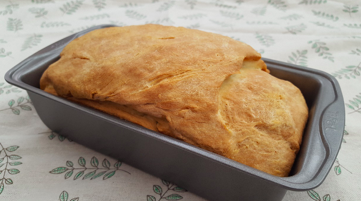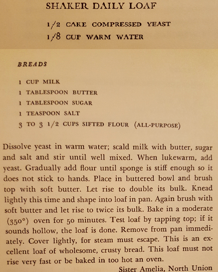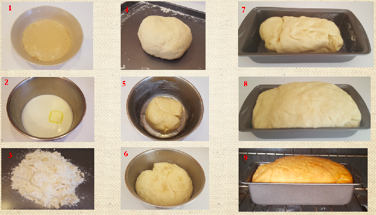Cookbooks & History: Shaker Bread
Students in Cookbooks and History (MET ML 630), directed by Dr. Karen Metheny, researched and recreated a historical recipe to bring in to class. They were instructed to note the challenges they faced, as well as define why they selected their recipe and why it appealed to them. Here is the fourth essay in this series, written by Ashley Lopes.
 Cookbooks and recipes are more than just ingredients on a list or words on a page. They tell us untold stories about historic communities, social networks, and meal systems. In my Cookbooks and History class, we learn how recipe collections transmit knowledge and reflect the changing practices and food landscape. What does the act of “doing cooking” convey? To answer this question, I recreated a historical recipe from Caroline Piercy’s The Shaker Cook Book (1953). The Shakers were a religious sect formed in the 18th century. They sought a utopian society where they could develop a spirit of community. In her book, Piercy compiles hundreds of traditional Shaker recipes, from pickles and preserves to breads and cakes.
Cookbooks and recipes are more than just ingredients on a list or words on a page. They tell us untold stories about historic communities, social networks, and meal systems. In my Cookbooks and History class, we learn how recipe collections transmit knowledge and reflect the changing practices and food landscape. What does the act of “doing cooking” convey? To answer this question, I recreated a historical recipe from Caroline Piercy’s The Shaker Cook Book (1953). The Shakers were a religious sect formed in the 18th century. They sought a utopian society where they could develop a spirit of community. In her book, Piercy compiles hundreds of traditional Shaker recipes, from pickles and preserves to breads and cakes.
The Recipe
 I chose to recreate “Shaker Daily Loaf” for a number of reasons: 1) I love bread. 2) Bread-making was an integral part of Shaker communities. Women often baked 20 to 30 loaves a day. 3) One of Piercy’s readers has inserted a handwritten loose-leaf paper, with an index of his/her favorite recipes. The Shaker Daily Loaf is included in this list, which suggests that the recipe is as practical as it is delicious.
I chose to recreate “Shaker Daily Loaf” for a number of reasons: 1) I love bread. 2) Bread-making was an integral part of Shaker communities. Women often baked 20 to 30 loaves a day. 3) One of Piercy’s readers has inserted a handwritten loose-leaf paper, with an index of his/her favorite recipes. The Shaker Daily Loaf is included in this list, which suggests that the recipe is as practical as it is delicious.
Many historical cookbooks (e.g. Lydia Maria Child’s The Frugal Housewife, 1830) rely on subjective forms of measurements, such as “butter the size of an egg.” The Shakers, however, were much more precise. Their bread recipe provides a standardized list of ingredients with exact measurements. The actual procedure is organized in paragraph style and specifies the baking time and oven temperature. Evidently, the Shakers demonstrated an understanding of domestic science and applied these methods in their cooking.
Challenges
The Shakers also relied on intuitive, preexisting knowledge. Some of the steps in their recipe lack instruction or explanation. For example, how do you know when the yeast is activated? How do you scald milk? Do you knead the dough twice? Should you cover the dough as it rises? With over 100 mouths to feed three times daily, Shaker communities were well acquainted with how to make the standard bread loaf. Perhaps this recipe was documented for their record-keeping, rather than for instructing the novice cook.
The main challenge I experienced in this recipe involved the application of yeast. The recipe calls for “1/2 cake compressed yeast,” dissolved in 1/8 cup of warm water. While the recipe specifies the quantity of cake yeast, it does not indicate the size. What’s more, cake yeast is often sold in different sizes, 0.6 oz to 2 oz blocks, at limited locations. This made things difficult for me. How do I accurately convert 1/2 cake yeast to the modern equivalent of dry active yeast? Initially, I dissolved half a packet (1/8 oz) of dry yeast with the 1/8 cup of warm water. The yeast failed to activate. I tried again and it failed once more. On my third try, I decided to follow the directions on the back of the Fleischmann’s dry yeast packet. I dissolved 1/4 oz of yeast with 1/4 cup of warm water and 1 teaspoon of sugar. Success! Within 10 minutes, the yeast began to bubble and form a creamy foam. I used only half of this yeast mixture with my flour and dry ingredients.
Transmission of Knowledge
 Apart from the yeast conversion, this Shaker recipe was relatively easy to replicate. The remaining instructions were fairly intuitive: knead the dough, let rise, knead again, let rise a final time, and bake. In all, the recipe assumes a great deal about the skill set of the reader. We may view the instructions as incomplete or lacking, but for the Shakers, this was all implied knowledge.
Apart from the yeast conversion, this Shaker recipe was relatively easy to replicate. The remaining instructions were fairly intuitive: knead the dough, let rise, knead again, let rise a final time, and bake. In all, the recipe assumes a great deal about the skill set of the reader. We may view the instructions as incomplete or lacking, but for the Shakers, this was all implied knowledge.
The Shakers practiced sensory engagement to guide the reader through each step. They relied less on measurable criteria and more on their own experience to determine when a food ingredient reached the correct consistency. For example, the recipe notes how the dough should feel, how it should look when risen, and how the finished loaf should sound: “Gradually add flour until sponge is stiff enough so it does not stick to hands … Let rise to double its bulk … Test loaf by tapping top; if it sounds hollow, the loaf is done.” Altogether, the Shakers demonstrate a utilitarian approach to baking, with writing that is more straightforward than personal. Bread was considered the “staff of life” and bread-making was a communal activity that fed hundreds of mouths daily. This process required nothing more than one’s own self and a loaf pan and oven.
Bibliography
Child, Lydia Maria. 1830. The Frugal Housewife. Second edition. Boston: Carter and Hendee.
Piercy, Caroline B. 1953. The Shaker Cook Book: Not by Bread Alone. New York: Crown Publishers, Inc.